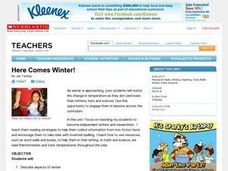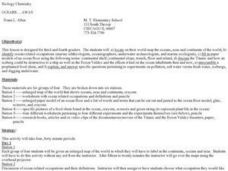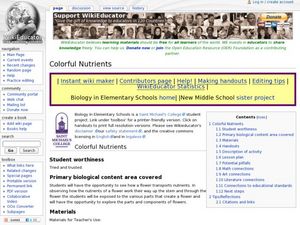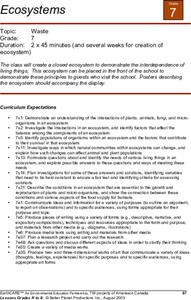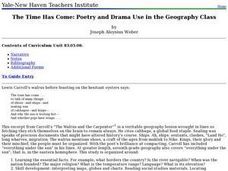Curated OER
Worms: Nature's Recyclers
Students explore vermi-composting. In this vermi-composting lesson, students listen to the story Diary of a Worm and discuss the parts of a worm. They create worm bins and add organic food for the worms to recycle.
Curated OER
The Sponges
In this sponge worksheet, students read about the different parts of a sponge and answer 20 short answer questions that follow. They color and label different sponge drawing.
Curated OER
The Real Deal on the Digestive System
Sixth graders explore the human body by viewing video clips. In this digestive system activity, 6th graders discuss what they think happens when they swallow food. Students view a Brain Pop clip demonstrating the digestion of food and...
Curated OER
Parts of the Plants
Second graders discuss as a class what they know about plants viewing several pictures of plants as well as a tree poster. They work in groups to observe a flowering plant which is removed from a pot with the soil brushed away and is...
Curated OER
Trash Bashing
Students define trash, garbage, or solid waste, discuss ways of disposing of trash, list examples of biodegradable materials, and have trash relay race in order to sort trash into appropriate containers labeled biodegradable, reusable,...
Curated OER
How Plants Spice Up Our Lives
Third graders study plants. In this biology lesson plan, 3rd graders label and identify parts of plants, identify spices obtained from plants, and determine what part of a plant a spice comes from by using taste, touch, smell and sight.
Curated OER
All About Birds
In this birds worksheet, students answer 25 short answer questions about birds. They color and label the different parts of a bird and fill in the correct term given the definitions.
Curated OER
Mollusks
In this mollusks worksheet, students color several figures and label them with the correct parts. They complete 14 short answer questions related to mollusks.
Curated OER
Here Comes Winter!
Learners investigate winter behaviors in animals. They describe winter and write about the characteristics of the season by drawing and labeling a winter picture. Students then conduct research on a chosen animal and create a chart. ...
Curated OER
On The Farm
Students study a dairy farm and also the crops that grow on farms. They research how we depend on farms to get the food we eat. They transform their findings and describe one the farms or make up their own. They turn the information...
Curated OER
Oceans Away
Students explore oceans. In this science lesson plan, students locate oceans, seas and continents of the world, identify ocean-related occupations, and complete activities pertaining to food chains as well as pollution.
Curated OER
Bacteria
In this bacteria worksheet, learners fill in the blanks with the correct word. Students then label the structures found on a bacterium.
Curated OER
Colorful Nutrients
Young scholars participate in an experiment to understand how plants get nutrients. In this plant nutrition, lesson students examine how colored water goes through the stem of a plant to the flower. Young scholars discuss the parts of...
Curated OER
Mollusk Matching
Students look carefully at shells and observe the differences between
species and the names of common shells. Then they identify and complete a Mollusk Matching handout included in the lesson and write the letter of each shell in the...
Curated OER
Working Together to Solve a Problem
Learners create a food and clothing drive at their school. In this philanthropy lesson, students listen to the story Selavi, That is Life, to help them understand homelessness. Then, learners brainstorm ways to implement a plan to...
Curated OER
Ecology of the Savanna-Forest Boundaries in Central Brazil
Students explore photosynthesis. In this photosynthesis lesson, students label parts of photosynthesis and take notes. Students conduct experiments on leaves, make observations and record their findings.
Curated OER
Ecosystems
Seventh graders create a closed ecosystem and place it where is it visible to others in the school. They label it with posters describing the interdependence of living things in the ecosystem. They discuss what might happen to the...
Curated OER
The Time Has Come: Poetry and Drama Use in the Geography Class
Students use drama and poetry in their Geography class. In groups, they role play an interviewer or the interviewee in various plays that were presented to them. In their role, they must locate and label where the countries mentioned...
Curated OER
Fruit or Vegetable?
Watermelon is a vegetable? A tomato is a fruit? Believe it or not, this debate is decades old. Groups examine rulings by the US Supreme Court, the USDA, and state statutes before developing their own criteria to use when labeling...
Curated OER
Put a Rainbow on Your Plate
In this nutrition worksheet, students investigate the importance of eating fruits and vegetables of different colors 5 times a day. Students complete 8 pages of activities such as menu planning, shopping lists, word search, word...
Curated OER
What Happens When You Eat?
Students explore digestion. In this Human Body lesson plan, students participate in six different activities pertaining to the Digestive System. Students gain understanding of digestion through experimentation and investigation. Students...
Curated OER
Action and Linking Verbs
In this recognizing action verbs and linking verbs in sentences worksheet, students read statements, identify the verbs, and label them either action or linking verbs. Students write 15 answers.
Curated OER
What Makes Up Your Profile?
Second graders understand what a profile is and relate to the profile of soil. In this soil profile activity students use cereal to simulate soil profile. Students draw and label their profiles using accurate soil vocabulary.
Curated OER
Lunch Menu Calories tracking project
In this lunch menu worksheet, learners make a spreadsheet where they count the calories of different food items on the lunch menu, chart their findings, and answer short answer questions. Students answer 5 questions.








